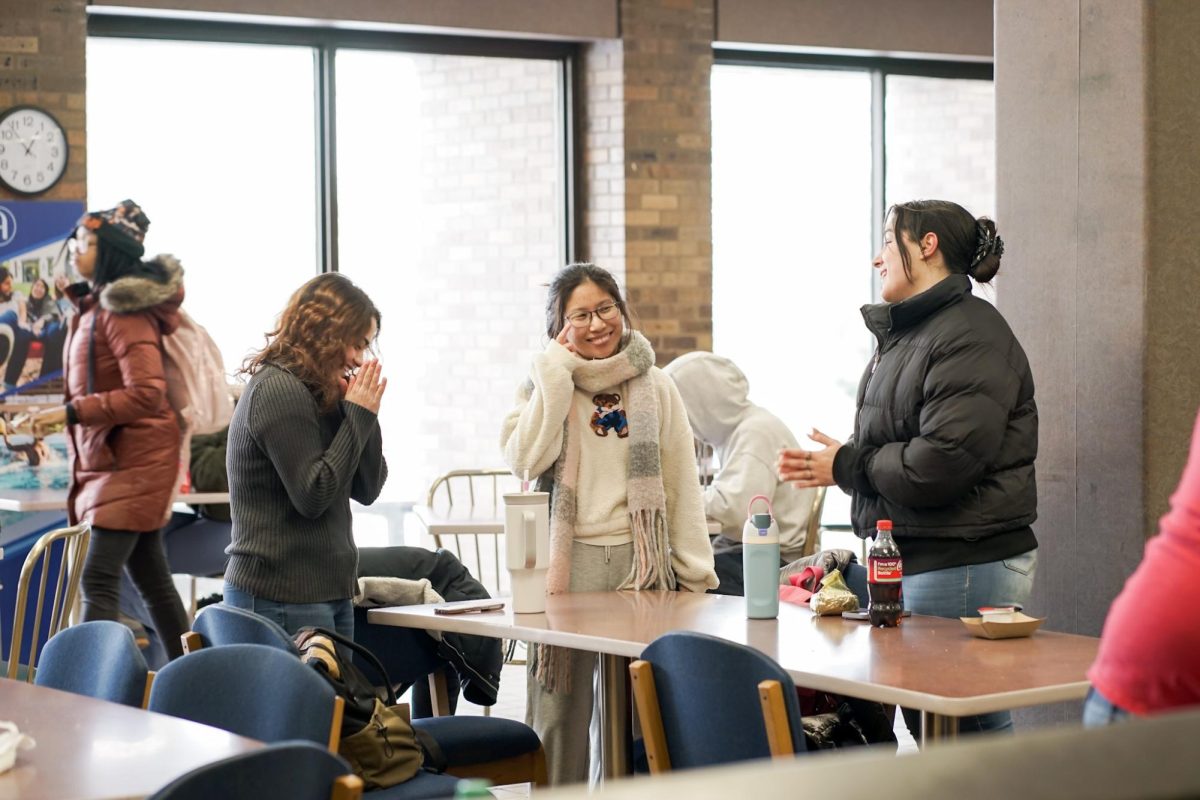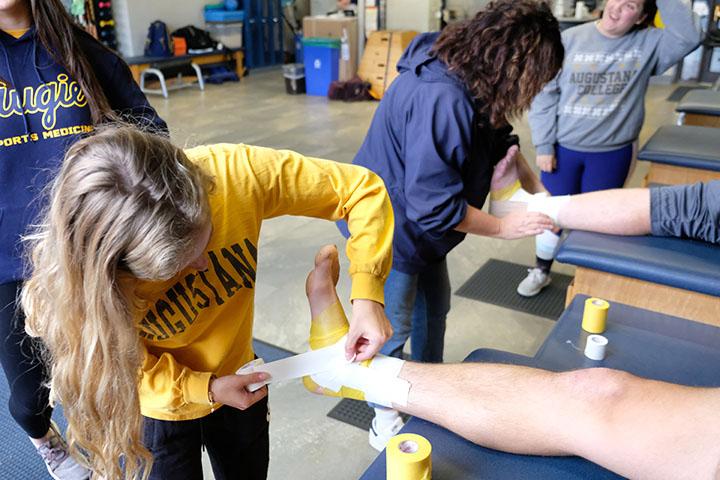For Augustana’s athletics, between 13 men’s varsity and 12 women’s varsity sports teams competing at the NCAA Division III level, there is a lot of work that goes into the wellness and success of each student athlete.
Not only do athletes receive the support of staff, administrators and coaches of Augustana, they also interact with the students who work as first responders, learning from our very own Certified Athletic Trainers.
The sports medicine staff has an important role in the athletic programs on campus, ensuring the safety and health of student athletes.
These student workers, called first responders, can be found on the sidelines of games and practices, in the training rooms taping and wrapping and, of course, always acquiring new skills from the Certified Athletic Trainers.
Junior first responder, Elizabeth Cook, is studying to go to medical school after after she graduates, and is currently in her second year of being a first responder.
“This has to be one of the coolest things that I am a part of on campus. All of my coworkers and the Certified’s [CATs] are great to work with. They turn what can sometimes be stressful, into a good time,” Cook said.
As an athlete herself, Cook is “used to simply doing the stretches and other rehab exercises without really knowing why [I] was doing it. Because of this job, [I have] become more aware of the way that each aspect helps [my] injuries as well as the athletes that [we] work with,” Cook said.
If you are an athlete, or even prefer to cheer our Vikings on from the stands, chances are, you also have noticed the Athletic trainers (CATs) standing near by. CATs not only keep the athletes safe, healthy, and happy, but they also teach student first responders about the important work they do.
One Certified Athletic Trainers is Jay Clark. Clark has been an Augie athletic trainer for five years and is currently in his ninth year of practice overall. He works with soccer, tennis and track and field.
“I really hope my students learn how much goes into taking care of our athletic population when no one is watching,” Clark said.“We are constantly trying to learn how to treat injuries better, and that means learning how to critique research, taking classes to improve our skill sets and how to better communicate with athletes so they are learning about their injuries in a positive way.”
Sports medicine at Augustana has two facilities on campus, one of which is located on the lower level of the PepsiCo Recreation Center. Although area of study is not a requirement to be a first responder, for sophomore Nick Teng, who is on the Pre-Physical Therapy track, it is an extremely useful step towards his future aspirations.
“One of the things that I enjoy most about this job is that it provides me with the opportunity to learn things that are related to my field,” Teng said. “The athletic trainers are very good about explaining why they do what they do when treating athletes. In helping them out, I also get more hands on experience with treating actual people which is an invaluable thing.”
Aside from the PepsiCo location, Augie sports medicine also works out of the training room in the lower level of the Roy J. Carver Center for Physical Education, and primarily works with the volleyball and football teams during the fall season each year.

Claire Borsch, a sophomore first responder on the Pre-Physical Therapy track,
briefly explains some of the responsibilities she has as a first responder for the football team.
This year, being her first time with the program, she said that one of the most difficult parts is getting used to where all the equipment is, how to use it and understanding different individualized treatments.
Junior first responder, Dillan Baum is majoring in Psychology and works alongside the women’s volleyball team, and brings a different kind of experience being a men’s volleyball player himself.
“As an athlete I’ve learned better ways to take care of myself and now with the training I’ve been through, I can help others which is pretty cool,” Baum said. “CATs are so essential to an athlete’s performance and are often overlooked, so getting to help them out and see all the things they do is pretty awesome.”
Year round, Augustana’s athletes participate in competition, getting the chance to showcase the hard work which they invest in their craft.
Alongside the hours of practice, conditioning and training, athletes require the support from a team of important people who play major roles in all of the athletic programs, here at Augie.
From the coaches and faculty mentors, to parents and fans, athletic trainers and first responders, Augie athletes are a product of much more than simply the performance we see out on the field or court.
Due to the susceptibility of an athlete to getting injured, one of the most prevalent pieces to the success of student athletes, is the sports medicine staff. The vital members of the sports medicine department work to prevent, treat, monitor and rehabilitate any physical health concerns of student athletes.
Regardless of which sport that is, maintaining the physical and mental health of the athlete will always be the number one priority of each athlete and all the people and programs who offer support. NCAA Division III competition is a physically demanding task, each sport posing various risks of injury and harm to the body.









































































































